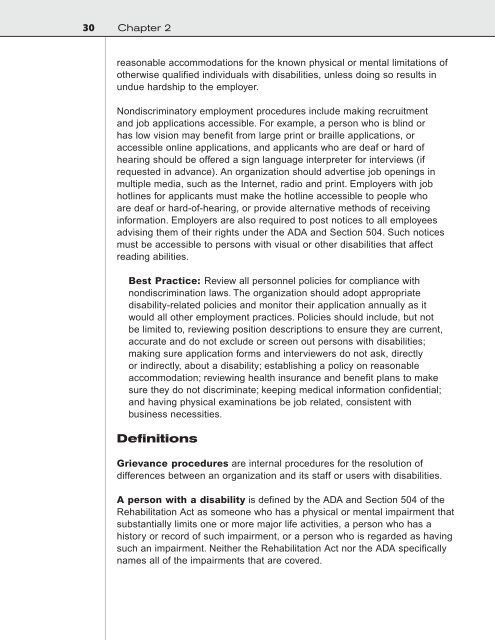Design for Accessibility: A Cultural Administrator's Handbook
Design for Accessibility: A Cultural Administrator's Handbook
Design for Accessibility: A Cultural Administrator's Handbook
Create successful ePaper yourself
Turn your PDF publications into a flip-book with our unique Google optimized e-Paper software.
30 Chapter 2<br />
reasonable accommodations <strong>for</strong> the known physical or mental limitations of<br />
otherwise qualified individuals with disabilities, unless doing so results in<br />
undue hardship to the employer.<br />
Nondiscriminatory employment procedures include making recruitment<br />
and job applications accessible. For example, a person who is blind or<br />
has low vision may benefit from large print or braille applications, or<br />
accessible online applications, and applicants who are deaf or hard of<br />
hearing should be offered a sign language interpreter <strong>for</strong> interviews (if<br />
requested in advance). An organization should advertise job openings in<br />
multiple media, such as the Internet, radio and print. Employers with job<br />
hotlines <strong>for</strong> applicants must make the hotline accessible to people who<br />
are deaf or hard-of-hearing, or provide alternative methods of receiving<br />
in<strong>for</strong>mation. Employers are also required to post notices to all employees<br />
advising them of their rights under the ADA and Section 504. Such notices<br />
must be accessible to persons with visual or other disabilities that affect<br />
reading abilities.<br />
Best Practice: Review all personnel policies <strong>for</strong> compliance with<br />
nondiscrimination laws. The organization should adopt appropriate<br />
disability-related policies and monitor their application annually as it<br />
would all other employment practices. Policies should include, but not<br />
be limited to, reviewing position descriptions to ensure they are current,<br />
accurate and do not exclude or screen out persons with disabilities;<br />
making sure application <strong>for</strong>ms and interviewers do not ask, directly<br />
or indirectly, about a disability; establishing a policy on reasonable<br />
accommodation; reviewing health insurance and benefit plans to make<br />
sure they do not discriminate; keeping medical in<strong>for</strong>mation confidential;<br />
and having physical examinations be job related, consistent with<br />
business necessities.<br />
Definitions<br />
Grievance procedures are internal procedures <strong>for</strong> the resolution of<br />
differences between an organization and its staff or users with disabilities.<br />
A person with a disability is defined by the ADA and Section 504 of the<br />
Rehabilitation Act as someone who has a physical or mental impairment that<br />
substantially limits one or more major life activities, a person who has a<br />
history or record of such impairment, or a person who is regarded as having<br />
such an impairment. Neither the Rehabilitation Act nor the ADA specifically<br />
names all of the impairments that are covered.


